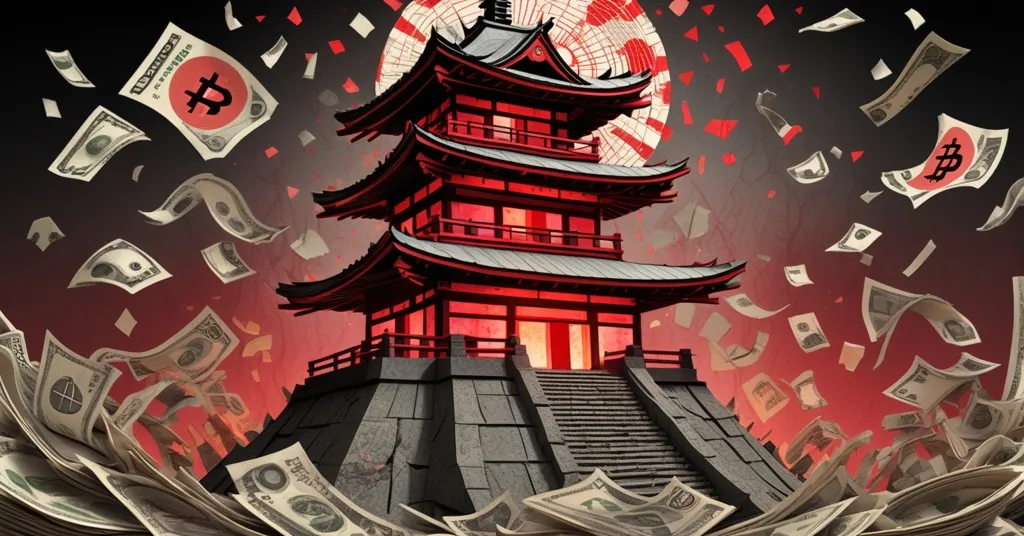Japan’s Bond Crisis: Traditional Finance Fails, Bitcoin’s Chance to Rise

Japan’s Bond Market Meltdown: A Wake-Up Call for Traditional Finance and Crypto’s Moment to Shine
Japan’s bond market is teetering on the edge of chaos, with skyrocketing yields and collapsing demand for government debt exposing deep cracks in one of the world’s largest financial systems. This isn’t just a local headache—it’s a global warning sign of traditional finance’s fragility, and a glaring opportunity for decentralized alternatives like Bitcoin to step into the spotlight. As policymakers scramble for answers, the situation begs the question: can centralized systems weather this storm, or is it time for a radical rethink?
- Record-High Yields: 30-year bonds at 3.2% and 40-year bonds peaking near 3.7%, signaling severe market stress.
- Vanishing Demand: Aging demographics and institutional investors are abandoning long-term debt, creating a buyers’ strike.
- Policy Crunch Time: The Bank of Japan (BoJ) faces pivotal decisions at its June 16 meeting amid rate hikes and tapering.
The Hard Numbers Behind Japan’s Bond Market Turmoil
Let’s cut to the chase: Japan’s government bond market is in a full-blown meltdown. Yields on 30-year Japanese Government Bonds (JGBs) have surged to around 3.2%, up from a modest 2.3% earlier this year, while 40-year bonds have hit highs near 3.7%, according to recent market data. For the uninitiated, bond yields rise when prices fall—meaning fewer people want to buy these long-term debts, forcing the government to offer higher returns to attract investors. This isn’t a minor blip; it’s a screaming red flag. A recent 20-year bond auction saw the lowest demand since 2012, and a 40-year sale recorded the weakest bid-to-cover ratio—a measure of how many bids are placed for each bond offered—in nearly a year. When even the most cautious investors are walking away, you know the house is on fire. For a deeper dive into the scale of this crisis, check out the ongoing pressure on Japan’s bond market.
Why does this matter? Government bonds are often seen as the bedrock of financial stability, a safe haven for capital in uncertain times. They’re how governments fund deficits, and in Japan’s case, with a public debt-to-GDP ratio among the highest globally, they’re a lifeline. Rising yields translate to higher borrowing costs for the government, which could strain budgets already stretched by needs like increased defense spending. If this spirals, it’s not just Japan’s problem—it’s everyone’s.
Why Demand for JGBs Is Evaporating
So, what’s behind this buyers’ strike? A massive chunk of the issue lies in Japan’s demographics. The country’s postwar baby boomers, once a steady source of capital for long-term government debt, are retiring in droves. They’re no longer locking up savings in 30- or 40-year bonds; they want liquidity to cover living expenses in their golden years. Kevin Zhao, head of global sovereign and currency strategy at UBS Asset Management, nailed it when he said:
“The country’s wealthy postwar baby boomers aren’t investing for the long term anymore.”
Then you’ve got institutional heavyweights like life insurance firms, historically big buyers of super-long bonds, stepping back. They’ve met their regulatory requirements or simply don’t see the value in tying up funds for decades at current rates, especially with inflation eating away at real returns. Add to that a government-backed investment scheme called NISA—tax-free accounts that are siphoning household savings away from bonds—and you’ve got a textbook case of demand drying up faster than a desert creek. Insights into this trend can be found in discussions on Japan’s demographic shift and bond demand.
Let’s not sugarcoat it: Japan’s been battling economic stagnation for decades, often dubbed the “Lost Decades,” marked by low growth and deflationary pressures. The bond market was propped up by ultra-loose policies, but now, with structural shifts like an aging population, the cracks are impossible to ignore. If traditional buyers are out, who’s left to hold the bag?
The Bank of Japan’s Dangerous Gamble
Enter the Bank of Japan (BoJ), the 800-pound gorilla in this market, owning roughly 52% of all JGBs. For years, the BoJ kept things afloat with near-zero interest rates and aggressive bond-buying programs, acting as a financial black hole swallowing up debt to stimulate the economy. But with inflation running above target for four straight years, the central bank is switching gears—and it’s a risky pivot. Interest rates are now at 0.5%, a significant jump for a country used to zero or negative rates, and bond purchases are being tapered by ¥400 billion (about $2.8 billion) per quarter, with plans to continue scaling back until March 2026. To understand the specifics of this shift, take a look at the BoJ’s bond tapering decisions.
This pullback is meant to tame inflation and normalize policy, but it’s like yanking the crutches away from a market already limping. With natural buyers scarce, less BoJ intervention means yields spike higher, as we’re seeing now. Benjamin Shatil, a senior economist at JPMorgan, didn’t hold back when he questioned:
“It all begs the question—why buy?”
He’s pointing to the BoJ’s sluggish response to inflation and market dynamics, and frankly, he’s got a point. The timing sucks. Commercial banks are facing liquidity squeezes, and the Ministry of Finance is mulling cuts to long-dated bond issuance to reduce supply pressure. Shinichiro Kadota, a strategist at Barclays, suggested a way forward:
“There may be some tweaks… but the solution has to be the Ministry of Finance [reducing] issuance.”
All eyes are on the BoJ’s Monetary Policy Committee meeting on June 16. Will they slow the tapering to cap yields, or double down and risk deeper market chaos? It’s a tightrope walk, and they’ve got no safety net. Worse, political pressures—like calls for tax cuts ahead of a July upper house election—are piling on fiscal strain, making any decision a potential landmine. For community perspectives on this turmoil, see the discussions on Reddit about BoJ policy impacts.
Global Fallout: A Financial Domino Effect
Japan isn’t an island in the financial sense—its troubles ripple outward. As the world’s second-largest creditor with over $3.7 trillion in net external assets, rising JGB yields could trigger capital repatriation, pulling money out of markets like the U.S. and tanking risk assets such as tech stocks. Analyst Albert Edwards of Societe Generale warned of a possible “global financial market Armageddon” if this spirals. Michael Gayed of Tidal Financial Group called Japan a “ticking time bomb,” noting that a loss of confidence in JGBs could shatter trust in global markets, especially if paired with a shaky U.S. dollar. Curious about the broader implications? Explore how Japan’s bond market influences global finance.
Then there’s the yen carry trade, a strategy where investors borrow cheap yen to fund higher-yield investments abroad. With the yen strengthening by 8% this year and JGB yields climbing, these trades could unwind violently, as we glimpsed in August 2024. Imagine investors dumping foreign assets en masse to cover yen loans—a sell-off that could hammer global markets. David Roche of Quantum Strategy added that higher JGB yields raise borrowing costs worldwide, potentially slashing global growth to 1% and prolonging bear markets. This isn’t just Japan’s mess; it’s a storm that could soak us all. Recent updates on this risk are available at coverage of BoJ policy and yield spikes.
Crypto’s Wake-Up Call: Decentralization in the Spotlight
Now, let’s talk about why this hits home for us in the crypto space. Japan’s bond market turmoil is a neon-lit billboard exposing the fragility of centralized financial systems. When policies lag—like the BoJ’s delayed reaction to inflation—or structural issues like an aging population erode stability, fiat currencies and government debt start looking like a house of cards. Bitcoin, with its fixed supply of 21 million coins and immunity to central bank meddling, stands as a potential hedge against this uncertainty. It’s not about printing money or tweaking rates; it’s a system where the rules are coded, not dictated by bureaucrats playing catch-up. For an interesting take on this, read about the potential link between Japan’s bond yields and crypto adoption.
Don’t get me wrong—Bitcoin isn’t a magic fix. Its price swings can be stomach-churning, with volatility that might scare off conservative Japanese investors used to the “safety” of bonds. And regulatory hurdles in Japan, where crypto laws are stringent, could slow adoption. But history shows that during fiat crises, like the inflation spikes of 2020, Bitcoin often correlates with gold as a store of value. It’s a bet on financial sovereignty, a middle finger to systems that buckle under bad policy.
Beyond Bitcoin, other blockchain technologies have roles to play. Ethereum’s decentralized finance (DeFi) protocols could offer lending and savings options as traditional liquidity dries up—think peer-to-peer loans without a bank’s red tape. Stablecoins like USDC provide fiat-like stability for those wary of crypto’s wild rides, while privacy coins like Monero appeal to freedom-focused folks in a surveillance-heavy society like Japan. Even Bitcoin’s Lightning Network, a layer-2 solution for faster, cheaper transactions, addresses scalability gripes. Sure, blockchain tech has growing pains—energy debates around Bitcoin mining, for one—but in a world where legacy finance is crumbling, these are problems worth solving.
Here’s a wild card: Japan’s crisis might fast-track their exploration of a central bank digital currency (CBDC), the digital yen. While it’s a state-controlled alternative to crypto, it’s still a nod to digital innovation. But let’s be real—a CBDC is just centralized finance with a tech facelift, lacking the permissionless, borderless ethos of Bitcoin. If anything, it’s a reminder of why we push for true decentralization, not government-controlled digital cash. For background on Japan’s staggering debt levels, refer to details on Japan’s national debt.
Key Takeaways and Questions to Ponder
- What’s fueling Japan’s bond market chaos in 2024?
A deadly mix of retiring baby boomers ditching long-term investments, life insurers stepping back from super-long bonds, and household savings flowing into tax-free NISA accounts over debt. - How is the Bank of Japan amplifying this financial storm?
By hiking rates to 0.5% and cutting bond purchases by billions quarterly, the BoJ is pulling back support when demand is already vanishing, driving yields to punishing highs. - Why should global markets worry about Japan’s bond woes?
As a top creditor, Japan’s rising yields could yank capital from U.S. and other markets, raise worldwide borrowing costs, and unravel risky yen carry trades, risking a broader financial quake. - Can Bitcoin capitalize on Japan’s economic instability?
Yes, turmoil in fiat and debt markets often boosts interest in decentralized assets like Bitcoin as shields against inflation and policy flops, though its volatility remains a sticking point. - What can blockchain tech offer beyond Bitcoin?
Ethereum’s DeFi platforms enable lending and savings without banks, stablecoins offer fiat-like calm, and solutions like Bitcoin’s Lightning Network tackle scalability—alternatives for investors fleeing traditional systems. - Are there quick fixes for Japan’s bond market mess?
The Ministry of Finance could slash bond issuance, and the BoJ might tweak tapering at its June 16 meeting, but deep issues like demographics mean this is a long-term battle.
Japan’s bond market meltdown is a stark reminder of how fragile centralized financial systems can be, especially when policy and demographics collide. The BoJ and Ministry of Finance are juggling dynamite, trying to balance inflation, market stability, and fiscal demands with no clear win in sight. For those of us rooting for decentralization, it’s a rallying cry. Bitcoin and blockchain tech aren’t just speculative plays—they’re potential escape routes from a legacy system showing its age. While crypto’s own flaws can’t be ignored, moments like this highlight why we need a parallel financial reality that doesn’t crumble under the weight of human error or inevitable societal shifts. Could this be the tremor that pushes Bitcoin mainstream, or are we still playing the long game for true disruption?



